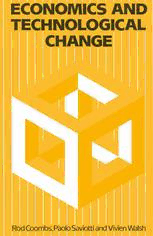
Economics and Technological Change PDF
Preview Economics and Technological Change
ECONOMICS AND TECHNOLOGICAL CHANGE Also by Rod Coombs TECHNOLOGY, ECONOMIC GROWTH AND THE LABOUR PROCESS(with Phil Blackburn and Kenneth Green) THE EFFECTS OF MICROELECTRONIC TECHNOLOGIES ON EMPLOYMENT PROSPECTS (with Kenneth Green and K. Holroyd) ECONOMICS AND TECHNOLOGICAL CHANGE Rod Coombs Paolo Saviotti and Vivien Walsh M MACMILLAN EDUCATION ©Rod Coombs. Paolo Saviotti and Vivien Walsh 1987 Allrights reserved.No reproduction. copy or transmission ofthispublication maybe made without written permission. Noparagraphofthispublication may be reproduced.copied ortransmittedsavewithwritten permission or inaccordance withthe provisionsofthe Copyright Act 1956(as amended). Anyperson whodoes any unauthorised act in relation to thispublication maybe liable to criminal prosecution and civilclaimsfordamages. Firstpublished 1987 Published by MACMILLAN EDUCATION LTD Houndmills, Basingstoke, Hampshire RG21 2XS and London Companiesand representatives throughout the world BritishLibraryCataloguing inPublication Data Coombs. Rod Economicsand technological change. 1. Technological innovations-Economicaspects I. Title II. Saviotti, Paolo m. Walsh. Vivien 338'.06 HC79.T4 ISBN978-0-333-37414-6 ISBN978-1-349-18683-9(eBook) DOI 10.1007/978-1-349-18683-9 Contents List ofTables ix List ofFigures x Foreword by Christopher Freeman xi Preface xiii Acknowledgements xv 1 INTRODUCTION 3 1.1 Changes in the perception and analysisof technological change 3 1.2 Technological change and institutions 6 1.3 Research and development, innovation and firm organisation 9 1.4 Static and dynamic perspectives 14 1.5 The problem of aggregation 15 1.6 Some methodological questions 17 1.7 Technological change and public policy 19 2 THE FIRM, PRODUCTION AND TECHNICAL CHANGE 23 2.1 The neo-classical theory of production 24 2.2 Post neo-classical theory of the firm 29 2.3 Managerial motivation 32 2.4 Firm structure 34 2.5 Technical change and the theory of the firm 39 2.6 Conclusion 48 3 RESEARCH AND DEVELOPMENT INTHE FIRM: I. STRATEGY AND STRUCTURE 50 3.1 Introduction 50 v vi Contents 3.2 The theoretical context of R&D strategy formulation 51 3.3 The determination of the R&D budget 55 3.4 The allocation of resources to major activities within R&D 60 3.5 Allocation of resources to broad areas 62 3.6 Allocation of resources to objectives within areas 64 3.7 Conclusion 67 4 RESEARCH AND DEVELOPMENT IN THE FIRM: II. ORGANISATION AND EXECUTION 70 4.1 Introduction 70 4.2 R&D projects 70 Origins of projects 70 Project evaluation and selection 74 Monitoring and control 82 4.3 The organisation of the R&D function 84 4.4 Conclusion 88 PART II ECONOMIC ANALYSIS AND TECHNOLOGICAL CHANGE 5 PATTERNS OF INNOVATION 93 5.1 The demand pull/technology push debate I: theoretical ancestry 94 5.2 The demand pull/technology push debate II: empirical studies 96 5.3.Induced innovation 104 5.4 Innovation firmsize and market structure 109 5.5 Technology, the selection environment and the firm 114 5.6 The diffusion of technological innovation 120 The epidemics model 121 Criticisms of the epidemics model and alternatives 124 5.7 Conclusion 133 6 TECHNOLOGICAL CHANGE, OUTPUT, EMPLOYMENT AND TRADE 135 6.1 Classical economists and economic growth 138 Contents vii 6.2 The Harrod-Domar model 139 6.3 Neo-classical models of economic growth 140 6.4 Heterodox approaches 145 6.5 An evolutionary approach to economic growth 146 6.6 Pasinetti's model of economic growth and structural change 149 6.7 Technological change and unemployment 151 6.8 Technological change and international trade 153 6.9 Conclusion 163 7 TECHNOLOGY AND STRUCTURAL CHANGE: OUTPUT AND EMPLOYMENT IN THE LONG RUN 165 7.1 Structural change 165 7.2 Long waves of economic growth 172 7.3 Neo-Schumpeterian theories of long waves 175 7.4 The role of the labour market 182 7.5 Institutional innovation in long waves 190 7.6 Information technology and the current long wave 193 7.7 Conclusion 195 PART III POLITICAL ANDSOCIAL ASPECTSOF TECHNOLOGICAL CHANGE 8 GOVERNMENT INTERVENTION IN TECHNICAL CHANGE 199 8.1 Introduction 199 8.2 The possibility of intervention 202 8.3 Why does government intervene? 205 8.4 Historical background to government intervention 212 9 THE PROMOTION AND CONTROL OF TECHNOLOGY BY GOVERNMENT 223 9.1 Introduction 223 9.2 Labour government policies for promotion of technology 224 9.3 Conservative policies for promotion of technology 229 viii Contents 9.4 The examples of aero engines and motor vehicles 233 9.5 Government policy and microelectronics 235 9.6 Some pre-conditions for government control of technology 238 9.7 Control of technology: attempts to anticipate the need for regulations 240 9.8 Mechanisms for the control of technology 241 9.9 Assessment of risk in the control of technology: the philosophy behind regulations 243 9.10Institutions for control of technology in the UK 246 9.11The effect of regulation on innovation 251 9.12Conclusions 253 10 NON-GOVERNMENT INFLUENCES ON TECHNICAL CHANGE 255 10.1 Introduction 255 10.2 Public participation in technology policy 256 10.3 The trade union movement 259 10.4 Pressure groups 264 10.5 Conflict and concensus 268 10.6 The role of experts 271 11 SUMMARY AND CONCLUSION 273 Bibliography 279 Index 293 Tables 4.1 Check-list of project evaluation criteria 78 5.1 Summary of innovation studies 98 7.1 Growth of real output over the long swing 173 7.2 Expansion and contraction over the long swing 173 7.3 Growth in world trade over the long swing 174 7.4 A simplified schematic representation of new technological systems 186 8.1 Resources devoted to R&D by sector of performance 204 8.2 Resources devoted to R&D by source of funds 204 8.3 Some US and UK legislation regulating the effects of technology 210 ix
